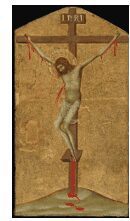Christ on the Cross
Art is integral to people’s daily lives, professionally or for entertainment. One significant artwork is titled Christ on the Cross, dated c. 1340. The art was created by Simone Martini, an Italian painter who painted the piece. This piece of art is located in the Harvard Art Museum at Harvard University, Cambridge, United States. The creation of art stems from numerous reasons, including enlightenment, revolution, and personal reasons. Therefore, artists have numerous reasons for the art they create. In this case, the artist’s message involves Christ’s suffering during the crucifixion, illustrated using visual art elements such as color, lines, shapes, mediums, and space.

Figure 1 Christ on the Cross (Martini).
Visual art elements employed in a piece of art help an artist convey their message. Simone portrays his message in the painting through the utilization of lines, which are vertical, curved, and horizontal. Lines are the continuous markings in a painting that accentuate and define shapes. Lines are evidently used in the Christ on the Cross painting, including vertical, curved, and horizontal lines; in the shape of the Cross created from vertical and horizontal lines, the figure of the body of Christ from curved lines, and the blood flowing from his wounds created from curved lines. The lines impact the painting in numerous ways because they help the painter establish his message of Christ’s suffering by depicting the scene involving Christ’s nailing on the Cross. For instance, they suggest movement as illustrated in the flowing and dripping blood and the movement of the clothing around His waist. Therefore, lines aid in illustrating the painter’s message of suffering in collaboration with other visual art elements, intensifying their impacts.
Further, Simone portrays his message in the painting by using color to create contrast, which includes red, brown, and golden. Color influences how people view and interpret art since it contributes to dramatization, affecting the interpretation and perception of the painting. Color also fills spaces in a painting, both negative and positive, on the ground where the Cross is placed and the background. The color adds to the outline created by lines indicated in the Cross, the body, the blood, and the background. Consistently, color impacts the painting by creating evident contrast between the background, Christ’s body, the Cross, and His blood. Thus, color aids in illustrating the painter’s message of suffering, evoking empathy in collaboration with other visual art elements by intensifying the contrast. For instance, the oozing blood in red helps emphasize the suffering of Christ during the crucifixion, which increases the empathy of viewers.

Figure 2 Christ on the Cross (Martini).
In conclusion, all visual arts elements impact an art piece, aiding in the portrayal of an artist’s message, including color, lines, shapes, and medium. Lines create outlines in an art piece, creating shapes such as the Cross and the body. Creating contrast is caused by colors, which are of a variety. Filling up outlines with color influences the perception of artwork because color impacts an artwork’s dramatization. For instance, the bleeding of Christ in the painting helps establish the painter’s message by accentuating His suffering and evoking viewers’ empathy. Therefore, art is significant for numerous reasons not only limited to history or enlightenment. In this case, the image is important to me because it portrays a detrimental part of history and religion. This detrimental part is a reminder of what was gained through loss. For Christians, this is a constant reminder of God’s love for all people, illustrated in the sacrifice of Christ for them. Therefore, art is important to people based on their interpretation and perception of an artist’s message.
Works Cited
Martini, Simone. Christ on the Cross. 1344, Harvard Art Museums, Harvard University. “Simone Martini – Google Arts & Culture.” Google, Google, July 1344, https://artsandculture.google.com/entity/simone-martini/m01fshq?categoryId=artist.
ORDER A PLAGIARISM-FREE PAPER HERE
We’ll write everything from scratch
Question 
Complete a four (4) paragraph draft of your essay (600 words)
Essay Reminders:
Your essay must include the image twice (labeled).
Your essay must include a Work Cited page (MLA).

Christ on the Cross
All of the words in the essay should be your own original thoughts and observations, though academic writing is in the third person- no “I” statements, except by how an image is important to you.
No external research is allowed.
IF YOU HAVE ANY QUESTION, LET ME KNOW